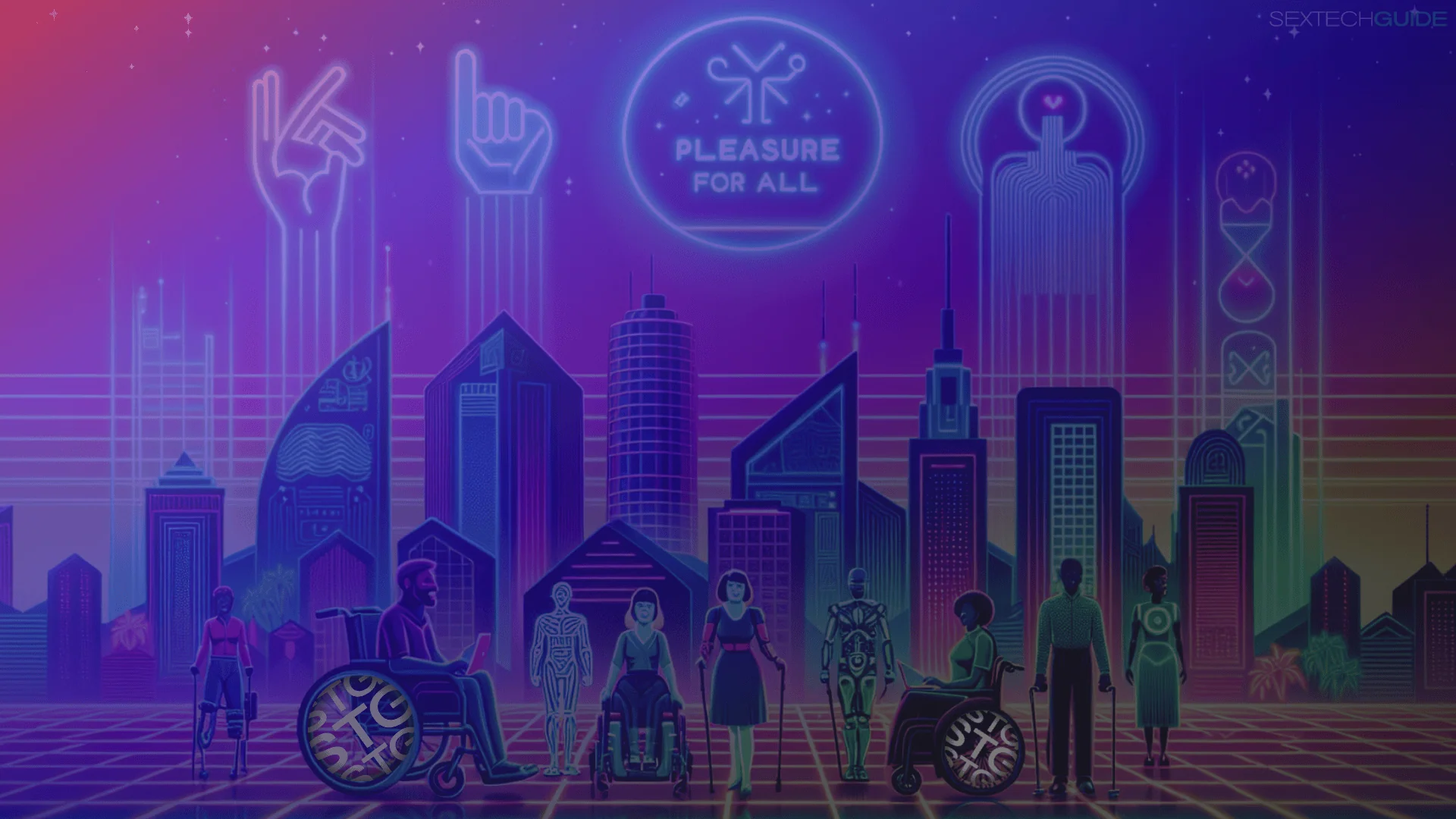Historically, disabled people have often been overlooked or misunderstood regarding their sexual needs and desires. This long-standing neglect continues to impact their ability to fully explore and enjoy their sexuality today.
The state of the sex tech industry is a shining example of this. Its focus on products for non-disabled people leaves disabled people reliant on adapting existing tech or making do with half-accessible tech that half gets them off. As a result of this neglect and various other aspects of entrenched ableism, disabled people sometimes get a late start when it comes to sex. Still, when they do come…they come hard.
While the sex tech industry continues to largely ignore the thriving sex lives of more than one billion disabled people on the planet—that’s 15 percent of the population—it remains a mystery why they don’t capitalize on this. In the UK alone, the disabled community has a combined spending power of £274 billion ($383 billion). In the US, some estimate that disabled people command $200 billion in spending power, others think it could be as high as $8 trillion.
So, what is missing from the sex industry to make it accessible? Who is leading the way toward a more accessible orgasmic future for all? And is the sex tech industry ever going to catch on to the sexual lives of disabled individuals?
Origins of sexual ableism
Historically, disabled sexuality has been mocked, denigrated, ignored, and, at worst, subdued through forced sterilization.
In the ancient world, parents of disabled children were encouraged to abandon them to preserve civilization. Later, long before human rights were a factor, many disabled people were locked up in asylums and sometimes sterilized without consent. Today, disabled people benefit from more rights and freedoms, but their sexuality is still treated with derision.
“For many people, the idea of disabled people being sexually desirable is unthinkable,” adds sex and relationship coach and founder of Love Uncommon, Sophia Graham. “Disability is all about limitation and aging and vulnerability and even death; the idea that we would have sexual lives, that people might desire our ‘imperfect’ bodies is abhorrent to some.”
The impacts of this enduring ableism are myriad. Disabled people face higher rates of sexually transmitted infections and difficulties accessing treatment and comprehensive sex education; often, schools exclude disabled people from sex education completely.
A largely inaccessible sex tech industry also has psychological fallout, as a lack of sex tech doesn’t just limit the disabled communities’ ability to find pleasure; it diminishes their sexual confidence, too, as Dr. Sarah Welsh, gynecologist and co-founder of HANX, explains.
Welsh explains that “being left out of the conversation when it comes to sex can deepen the very real sense of isolation felt by many in the disabled community and, furthermore, impact the sexual sense of self.”

The positive impact of sex tech
Sex tech has become commonplace across the world, seamlessly intertwining with millions of people’s sex lives. And when these advancements in technology consider disabled people’s needs, they make pleasure more accessible to people of all ages and abilities.
Plus, for folks like Sparrow, founder of Pastel Poisons, a disabled part-time jeweler and kink toy maker, sex tech empowers disabled people to feel in control of their bodies while forging deeper connections with others. This is desperately needed, considering the research by accessible sex toy company Bump’n that showed that 50 percent of physically disabled people struggle to achieve sexual pleasure independently.
“Being able to integrate sex tech into my bedroom time has allowed me to have actually fulfilling interactions instead of lackluster ones,” shares Sparrow. Not to mention “the fact that things like wedge pillows, sex slings, and suction-cup toys have become a common sight both online and in brick-and-mortar adult stores mean that it’s less of an eyebrow-raising moment when they get pulled out, and more of an ‘oh, you’ve got the good stuff.’”

State of the sextech industry for disabled people
Despite disabled people populating 16% of the world, few sex tech brands or toy designers meet the needs of disabled people searching for their next orgasm.
The scale of the neglect is hard to quantify with statistics because (surprise!) scant research is available. The broad spectrum of disability also complicates the situation; our needs vary drastically, and many disabilities are invisible.
However, a deep dive into the websites of some of the world’s top sex toy brands, such as Lovehoney and Ann Summers, reveals a dearth of sex tech for disabled people. Few websites highlight accessible tech features, and fewer still sell tech with disability in mind.
“Most toys these days have things like discrete, ergonomic designs that work great for able-bodied people, but we’re still missing really simple things—small buttons that are crowded together without any major tactile design, toys that are completely smooth with no grip points, toys that require the user to assume certain positions to use, and toys that have fiddly chargers or charging docks,” says Sparrow.
Numerous smaller brands and Etsy sellers create products specifically with disability in mind, such as positional pillows, supports or swings for wheelchair users, and arthritis-friendly vibrators. However, the progress slows to glacial when looking at more prominent brands, with most tech designers seemingly not considering accessibility at all. Not to mention, Etsy’s ban on adult products.
It appears that while half the industry doesn’t know or want to admit that disabled people want to enhance their sex lives with sex tech, the other half want to help but don’t know how to design accessible toys.
Graham also thinks the industry focuses too much on specific groups, forcing unrepresented folks to figure out their own solutions by adapting existing tech.
“I think spending more time thinking about older bodies, queer sex, and disabled sex would help companies to innovate and create products that would help a lot more people to have the sex lives they want,” Graham says. “If I can create a better platform to have sex on from a children’s swing base and custom-made outdoor cushion than I could find on the market, something is wrong!”
Meeting disabled peoples’ sexual needs with care
At first look, the market appears desolate, but some progressive thinkers are leading the way to improve the state of accessible sex tech.
Andrew Gurza and Heather Morrison founded Bump’n (which was subsequently cancelled ahead of production), set out to create accessible sex toys for people with physical disabilities. Australian sex toy company Luddi creates inclusive toys for people of all genders and abilities.
As seems typical for groundbreaking developments, smaller companies with the lowest budgets are taking on the problem first.
“As a small business, our aim to promote inclusivity through physical products can often take longer thanks to less financial resources than major mainstream brands and the limitations of our manufacturers,” says Welsh.
Companies like Hanx set an example for others by creating products that consider their audience’s various needs, most notably with their first sex toy, Cindy. “The result: a non-penetrative pleasure partner that can be operated easily, especially if manual dexterity is more tricky. We also love working with a range of sex educators and creators, whose expertise and unique experiences help promote a more inclusive view of sexuality.”
Sex doll manufacturers Doll Authority puts the audience’s needs at the heart of their work, creating dolls that prioritize accessibility through consultations with disabled people to perfect designs.
“We focus on creating customizable and ergonomic features that cater to various physical needs,” says Dr. Olivia Lee, a therapist and relationship expert in residence at Doll Authority. “For example, our dolls can be adjusted for different mobility levels, and we offer a range of products to ensure ease of use.”
Sadly, though, many accessible toys lack global reach, and development is slower without the mega-budget to back it up. Although these companies’ impact is not to be undermined, not everyone can afford their products or ship them to their own country. The industry needs larger companies to join in on the efforts to increase access and choice for disabled pleasure seekers.
Sparrow hopes that mainstream companies with the budget to back up big ideas will look to independent sellers to learn from their work. “So many small creators have already worked hard to produce things like adapters, handles, brackets, and more. It would be wonderful to see these ideas picked up by larger companies or to see them financially backed to make them more available to the people needing them.”

The next step for accessible sex tech
Progress is happening in the sex tech industry. However, there are still a few mountains to conquer before the sexuality of disabled people is embraced in the sex tech world.
“So often, the bottom line of whether a product makes it to the shelves is how widely they can market the item and what return they can expect on it,” says Sparrow. “If they can’t make it ‘sexy’ if the product looks too much like it might be for disabled folks, it hits the market with that stigma already attached, completely disregarding the fact that disabled people aren’t the only ones that stand to benefit from them!”
Breaking down a few millennia’s worth of stigma is no easy feat. It’ll start with improving representation so that people no longer react with disdain or confusion when disabled people want sex and the tech to make it mind-blowing.
Once companies can bear to think of a disabled person’s sexuality, they’ll see how easy it is to increase sex tech accessibility. Many existing designs only need a few adjustments to cater to disabled people.
“With the advances we’ve seen in tech in the last few years, there is a huge opportunity for accessible tech to ensure that we can bridge that gap,” says Sparrow. “So many toys these days come with things like long-distance play via Bluetooth integration; adding another feature for hands-free spoken commands seems like an obvious suggestion, as does having options for screen-reading and audio confirmation for options.”
Lee also believes the industry’s discomfort around disabled sexuality collides with a fear of causing offense, and an attitude shift is an essential part of making change. “Many well-intentioned manufacturers are simply afraid to offend disabled people by explicitly marketing to them or using the wrong terms to address them. It’s crucial for the industry to move past these biases and realize the potential for innovation within this significant market segment.”
Ultimately, the most critical element in advancing the accessibility of sex tech is the inclusion of disabled people in every step of the design and testing process. Too often, companies dive into designing products without consulting anyone outside their offices. Long-lasting advancements in sex tech for disabled people must grow from within the community.
“Consult. Disabled. People. It’s really that simple,” says Sparrow. “Give us room at the table, and actually listen to the results; you might find yourself surprised by how horny we actually are!”






Leave a Reply